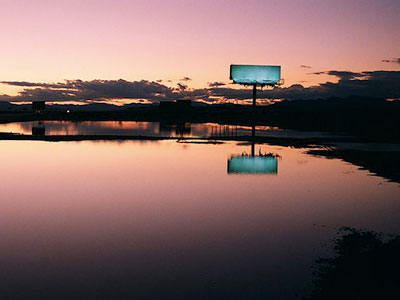On-premises signs identify property tenants or provide information about goods and services offered on the same lot the sign is located on.
Off-premises signs, like billboards, direct a viewer’s attention to goods and services offered in a different location.
Well-designed signs can reinforce a community’s identity.
How it Works
Signs display an image and communicate a message for various functions, such as wayfinding, identifying properties and businesses, and advertising products and services. Signs can function on-premises or off-premises. On-premises signs display information about something on the premises on which the sign is located. Off-premises signs, like billboards, display information about a business, person, organization, activity, event, place, service, or product not principally located, manufactured, or sold on the premises where the sign is located. Some signs are temporary, such as yard signs, while others are permanently mounted. Some permanent signs are attached to buildings while others are freestanding. The location, scale, height, and type of signs varies greatly and depends on how they are expected to be viewed. Well designed signs can contribute to the character and visual harmony of communities.
Although signs are intended to attract attention, they can create hazards and degradation of community character. If billboards, for instance, do not have reasonable locational, dimensional and illumination limits they can potentially create unsafe conditions for motorists and others and emit light trespass or glare on nearby residents or businesses. A municipality can regulate signs through its zoning ordinance using reasonable and objective standards that protect the public’s health, safety, welfare, and community character.
Benefits
Enhance Public Safety
Municipal sign regulations can reduce potential hazards to pedestrians and motorists.
Preserve Community Character
Effective municipal sign regulations can limit visual clutter, prevent over concentration, and promote well-designed and placed signs that reflect a community's "sense of place."
Protect the Environment
With reasonable limits on all types of signs, regulations can help minimize the potential impacts of light pollution, glare, and energy consumption.
Provide Predictability
Clearly written sign regulations can establish a process for review and approval that creates predictable results for sign developers and the community at large.
Support Businesses
Standardized sign regulations assure businesses that all signs are viable and legible for the public without one or two outsized or glaring signs overpowering the signs of other businesses.
In addition to the sign regulations in the zoning code, the modification, removal, or construction of signage within a designated historic district is commonly regulated by the local Historic Architectural Review Board (HARB).
Illustrations help clarify the intent of dimentional standards in sign regulations. This illustration from Lower Merion Township, PA depicts specific regulations pertaining to wall type signs.
Digital display and electronic messaging may not be appropriate in certain locations.
Get Started
Regulating signs within a municipality’s zoning ordinance is the most common approach to establishing standards to protect the public’s health, safety, welfare, and community character. This approach allows for standards specific to the character of zoning districts and the application of existing administrative and enforcement procedures. Zoning standards can address size, height, clearance, location, form, material, number, orientation, and illumination to minimize possible adverse impacts on nearby public and private property. For simplification, existing zoning administration and enforcement procedures for non-conforming uses, permitting, inspections, penalties, and variances can be applied to the standards.
Placing sign regulations in an ordinance chapter other than the zoning ordinance is also a possible approach and allows flexibility when administering appeals. Different appeals procedures can be developed rather than variance requests and the need for action by a zoning hearing board when a signage proposal does not meet standards in a zoning ordinance.
Considerations
Legal Issues
While the focus of regulating signs is to control the time, placement, size, and design of signs to protect the public safety and welfare, it is very important to avoid standards that exclude a particular type of sign completely, establish standards for color, font, and other design factors, restrict content, or limit free speech. Municipalities should seek legal guidance when considering regulations pertaining to these issues.
Community Characteristics
Municipalities should reference design guidelines or its comprehensive plan to help define the identity or character they wish to protect to further support their case for regulating signs. In addition, municipalities should encourage on-premises signs that are complimentary to their associated building and landscaping elements.
Historic District Standards
In addition to sign regulations in their zoning code, municipalities may have regulations pertaining to the modification, removal, or construction of signs within designated historic districts. These areas should promote hanging signs and monument signs versus signs on single poles. These areas should also restrict internally illuminated signs, which transmit a great degree of glare and are inconsistent with traditional sign characteristics. The local Historic Architectural Review Board (HARB) can regulate these additional standards.
Off-Premises Sign Sizes and Locations
The size of off-premises signs should reflect the posted speed limit of the road which the sign faces. This allows a sign located along a roadway with higher speed limit to have a larger sign than those located on roads with slower speed limits. Consider a maximum size of 300 square feet for off-premises signs located adjacent to limited access roadways. Signs any size larger should not be allowed or should only be allowed by special exception to consider additional potential impacts. Allowable locations should consider adjacent land uses, potential impacts on residences, presence of additional signs, roadway geometry, intersection locations, and driveways. Billboards are generally more appropriate in non-residential areas, particularly industrial districts.
Digital Display Standards
The use of digital signs provides convenience to commercial and municipal entities to change display information quickly and remotely. The increasing presence of these sign types has raised concerns about their impact on driver safety, energy consumption, and increased light pollution. Municipalities can address these concerns by permitting digital displays on a district-by-district basis, designating a minimum message duration time, and reasonably restricting brightness level and hours of operation. Requiring the preparation of an illumination study will help determine brightness levels and the potential for disabling glare and light trespass.
Location Standards
The location of signs should not interfere with official street signage, sight triangles at intersections, the clearance of pedestrian and vehicle travel ways, utility and communications equipment, or the public right-of-way.
Municipalities should have different sign standards for different types of zoning districts. The size and brightness of signs should be very limited in residential or institutional districts. In village areas, downtown, and other historic areas, signs should be designed to be compatible with the local character, using regulations similar to those often used in Historic Districts.
Dimensional Standards
The maximum height and area of signs is usually regulated by sign type. The basis for measuring signs is typically explained in the zoning regulations.
Illumination Standards
It is recommended that illumination of signs, excluding electronic message signs and digital displays, be limited by standards for external and internal illumination. External lighting should be from above and shielded from any street right-of-way. Internal illumination should be limited to halo-lit or backlit channel letters, icons, and logos. Allowing the use of large panel internally illuminated signs is not recommended, especially in historic districts and in Chester County's rural center landscapes.
Enforcement
Employ enforcement measures to ensure the conditions of municipal approval are observed.

Examples
East Goshen Township
East Goshen Township's Zoning Ordinance regulates digital signs by limiting dwell time to 10 seconds, prohibiting animation, and requiring transitions less than one second. Brightness controls are required, and the display is not permitted to distract from traffic signals.

West Grove Borough
West Grove Borough's Zoning Ordinance regulates digital signs by limiting dwell time to a minimum of six seconds, prohibiting animation, prohibiting scrolling, requiring transitions within one second, requiring automatic day/night dimming, and requiring automatic shut-off in case of failure.








